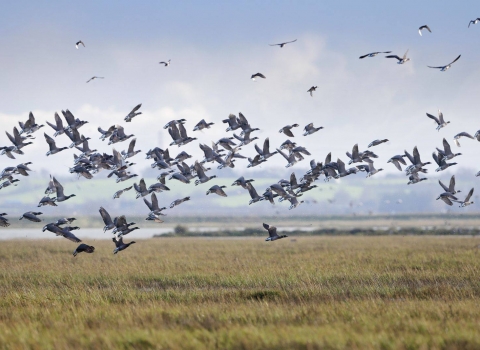Following the epic 2,500-mile migration of the dark-bellied brent goose
Essex Wildlife Trust and the Southern Colour Ringing Group have launched a satellite tagging project, to track how dark-bellied brent geese use the Essex coastline over winter and to follow their journey back to the breeding grounds in Siberia. The dark-bellied brent goose arrives in Essex from October, with over a quarter of the world’s population spending the winter months around the Essex coast, then in March they begin their epic migration once again.
Satellite tags allow us to gain invaluable data on the geese’s movements and in time, the data will identify sites that are important for the geese and help to inform future landscape-scale conservation efforts. We’re especially interested in finding out how the brent geese are using the Essex coastline and the data will feed into the management plans of our nature reserves and inform stakeholders in the wider landscape.
The brent goose’s migratory journey 2020
March saw the start of the epic migration for the dark-bellied brent geese that had just left our Blue House Farm nature reserve and were enroute to their breeding grounds in eastern Siberia. Tracked with small satellite GPS tags, we have now successfully tracked one goose all the way back to Russia, on one incredible journey.
In late March, one of our GPS tagged birds ‘Bran17’ was tracked flying to the German Wadden Sea. Here, he spent two months feeding and resting on the coast of northern Germany before the real sprint finish began on Saturday 23 May. By midnight, the male bird passed to the south of Copenhagen and crossed the very southern tip of Sweden, heading out across the Baltic Sea.
By 6am on 24 May, the bird passed Gotland, a large Swedish island in the middle of the Baltic Sea. The bird then continued to cross the Baltic Sea and after travelling 630 miles, he finally had a rest stop in a bay on the Estonian island of Hiiu.
The rest didn’t last long though, a mere 12 hours, at around 6pm on 25 May, the bird headed up the Gulf of Finland, with Finland to the north and Estonia to the south, Harry Smith, Warden at Blue House Farm The brent goose’s migratory journey passing the cities of Helsinki and Tallin. By midnight on 25 May, the goose had reached the west coast of Russia. That day,
The bird crossed Lake Ladoga in north west Russia, in the vicinity of St. Petersburg and by6pm on 26 May, the bird arrived in Lake Lizhmozero, in northwest Russia. ‘Bran17’ had covered 504 miles since his last resting site and a grand total of 1,134 miles in 60 hours from the north coast of Germany!
This is our last GPS data point so far but we are hoping to receive further data when the bird travels west again onits way back to Blue House Farm nature reserve.

